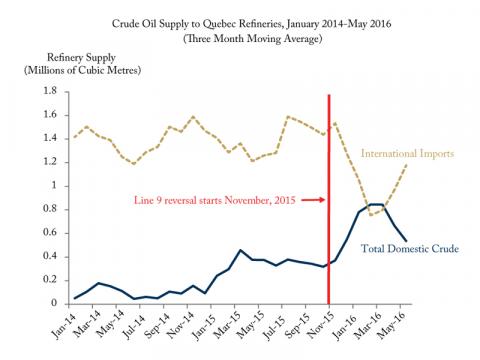Pour la version française, cliquez ici.
From: Ben Dachis
To: The Hon. Jim Carr, Minister of Natural Resources
Date: September 1st, 2016
Re: How Much Did A New Pipeline Reduce Canadian Dependence on Foreign Oil?
Could new pipelines result in Canada using less foreign oil? The latest evidence from the recent reversal and capacity expansion of Enbridge’s Line 9, which runs from Michigan to Montreal, suggests that Quebec reduced its reliance on foreign oil once it had access to Canadian sources.
The figure below shows the three-month moving average of the sources of crude oil at Quebec’s refineries. Until January 2015, the only domestic oil that came to Quebec was from Eastern Canada. Some Western Canadian oil started arriving then, probably by train. Foreign oil provided about 85 percent of refinery oil.
In November of 2015, Enbridge’s Line 9 started to serve the Montreal area, reversing the flow of previous years. Canadian oil started to supplant foreign oil barrel-for-barrel because total Quebec refinery demand stayed flat. In the spring of 2016, Quebec refineries received more oil from domestic sources than imports for the first time.
The spike of imports in May of 2016 may have been due to wildfires that shut down much of the Alberta oil sands. We will see over the coming months if oil imports hold their ground. Other pipeline expansions will not have an identical effect. But the evidence so far is clear: recent pipeline expansions to serve Eastern Canada likely resulted in domestic oil replacing imported oil.
Governments should not necessarily prioritize domestic oil over imports for Canadian consumers. But to the extent that there are benefits to Canada of using domestic oil over foreign oil, recently built pipelines have helped. Your government should keep that in mind as you review the pipeline applications in front of you.
Source: Author’s calculations from CANSIM Table 134-0001. Note: A few assumptions were necessary to calculate Quebec’s oil imports shown in the chart above, because Statistics Canada suppresses some data. Data suppression protects data when overall levels are small or dominated by a single company. First, I assume that any suppressed non-US monthly import data were so small as to be negligible. Second, Statistics Canada only reports imports to Quebec from the US – mostly by rail – for a few months. In those few months that Statistics Canada does show data, Quebec was the destination for about 60 percent of the US-imported oil to Canadian refineries. I thus assume that Quebec received 60 percent of total Canada-bound US oil. Third, Statistics Canada also suppresses a small handful of months for total imports from the US to Canada. I assume that those suppressed months are an average of the adjacent months in which Statistics Canada reports data. Canadian oil exports by rail are consistent month-to-month. Imports likely are too. This method lines up closely with total refinery supplies in Quebec.
Benjamin Dachis is Associate Director, Research, at the C.D. Howe Institute.
To send a comment or leave feedback, email us at blog@cdhowe.org.






